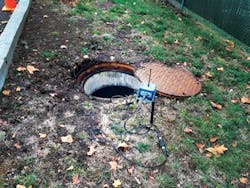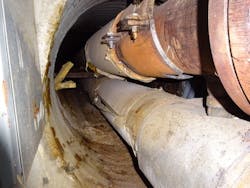About the author: Michael Meyer is associate editor for W&WD. Meyer can be reached at [email protected] or 847.954.7940.
In Fairbanks, Alaska, the matter of water main replacement is not to be taken lightly. The city—the second-largest in the state—is located just south of the Arctic Circle and is commonly called the coldest city in the U.S., according to AccuWeather, with an average monthly low temperature of -16.9°F. Its lengthy brutal winters freeze the ground for much of the year, so replacing pipe can be extremely cost- and labor-intensive. Given this, one local utility with a limited budget chose to use acoustic condition assessment from Echologics in the summer of 2016 to determine the state of two sections of its pipe, and the results of the survey are already paying dividends.
Replacement Approach
Doyon Utilities is a privately held company that owns and operates the water and electrical utilities for three U.S. Army bases in Alaska: Fort Wainwright in Fairbanks, Fort Greely in Delta Junction and the Fort Richardson portion of Joint Base Elmendorf-Richardson in Anchorage. Doyon Utilities was awarded government contracts for these installations in 2008, and since then, the operators of these utilities have attempted to assess the condition of their water network. At Fort Wainwright, that duty falls to Capital Programs Manager Mac Nason.
“For military installations across the U.S.—very much like municipalities—the investment into the infrastructure has varied over the last 50 years,” said Nason. “We’ve been working to get current condition data on this infrastructure that we now own and operate under the contract with the U.S. Department of Defense. I’ve got a lot of historic information, and I’ve built capital improvement plans based on that.”
One of Nason’s projects involved the rehabilitation of two lengthy stretches of troublesome water main, but a simple replacement program proved to be a non-starter.
“The piping that we looked at with this project was along Neely Road and Luzon Avenue, two separate stretches on the installation,” Nason said. “They’d been having some problems, particularly on the Luzon Avenue stretches, with pipe leaks and serious issues. Based on historic documents, I developed three projects to do the standard ‘renewal through replacement.’” But with an estimated dollar amount “in the neighborhood of $25 million,” the projects were considered unaffordable.
Sound Solution
Nason went back to the drawing board to devise a new way to address the problem. At an Alaska Water Wastewater Management Assn. conference, he attended a presentation given by Echologics, which demonstrated its ePulse technology. ePulse is a noninvasive acoustic technique that assesses pipe condition, detects leaks and determines the pipe’s remaining service life.
“We take all the information about what the pipe material is, the time frame it was installed and the diameter of the pipe, and then we factor in what the wall thickness was when it was put in new or what the specs are of that type of pipe,” said Corey Keefer, western region sales manager for Echologics. “The speed of sound that travels through the pipe is going to be much less rapid if it’s degraded or if the pipe is in bad condition. There’s a lot that goes on behind the scenes from the engineering side, and all the information that [comes] out from the data gives us a final report on what the condition of the pipe is—good, moderate or poor condition.”
Nason was intrigued by the possibility of using ePulse technology. He met with Echologics engineers and spoke with employees of the Anchorage Water & Wastewater Utility, which had successfully deployed Echologics technologies on pipe condition assessment projects in the past. Nason subsequently suggested using ePulse technology to the Army, and the project was approved.
“Our one customer at Fort Wainwright is the Army, so there’s a lot more direct involvement between us and them when it comes to capital projects,” Nason said. “They were very much in favor of using condition assessment to target what we were going to have to actually do for capital improvements.”
Pinpointing Problems
A condition assessment team traveled to Fort Wainwright in late August 2016. From Aug. 29 to Sept. 2, they tested more than 2 miles of pipe in segments. “The field crew they sent was all of two people,” Nason said, adding that the technology they used was unobtrusive. “It doesn’t take any excavation and we didn’t have to shut anything down. You keep the lines in service.”
The survey paid immediate dividends when a significant leak was discovered in one of the base’s fire hydrants. “They found a 30-gal-per-minute (gpm) leak in a fire hydrant along Neely Road,” Nason said. “They passed that information to our [operations and maintenance] guys, and they were able to get on that right away.”
The cost savings from this discovery alone justified the expense of the survey. “An estimated combined water loss of 30 gpm is roughly 43,000 gal per day, so that’s about $150,000 per year, just off of that one leak. [This is] based on their rates and the cost of water,” Keefer said. “Off of that one leak that they found, it paid for the entire service that we did.”
Doyon Utilities was provided with a thorough report of the inspection’s findings shortly thereafter. The survey revealed that much of the pipe was still in good to moderate condition, but two segments were found to be in poor condition. Determining the precise areas where service is needed has helped Nason significantly reduce the amount that will need to be spent on the pipeline rehabilitation project. “Off the top of my head, I’m thinking we’re going to see at least a 50%, if not greater, cost reduction by being able to target specifics, versus going in and removing it all and replacing it,” he said.
New Beginnings
Nason was impressed by Echologics’ service and plans to continue working with the company as the Fort Wainwright infrastructure assessment project enters its next phase.
“This was the first time that we had used Echologics, and it was definitely a very worthwhile experience working with them,” he said. “As I get my condition assessment program going, Echologics [is] at the top of my list to use.”

